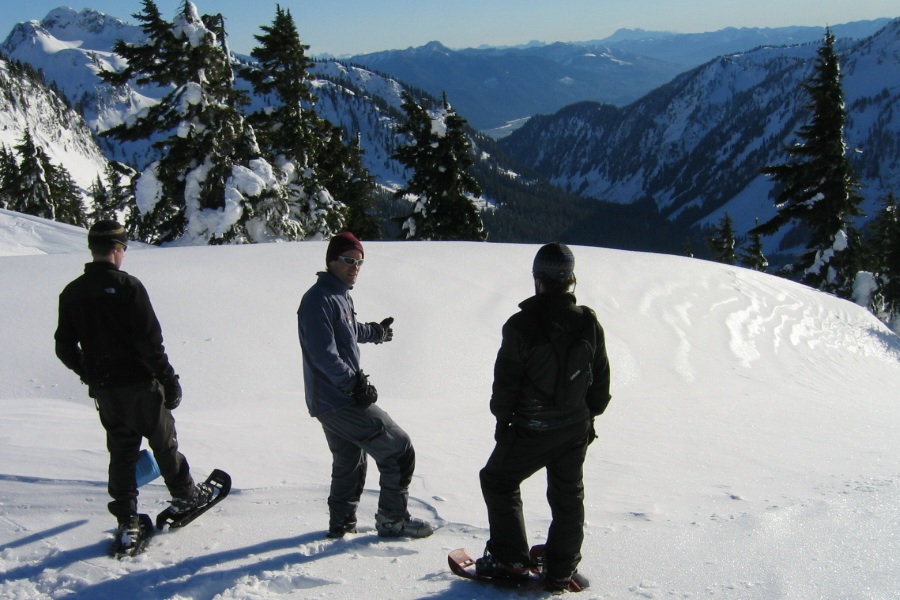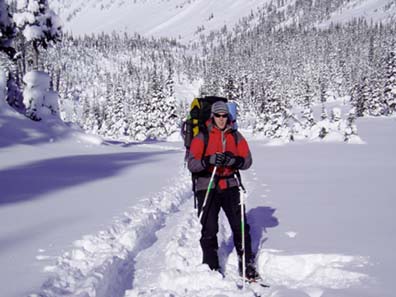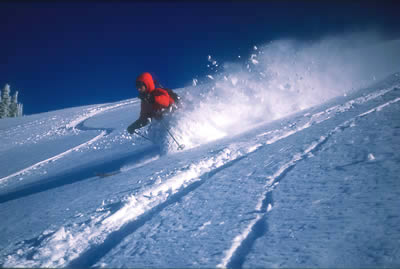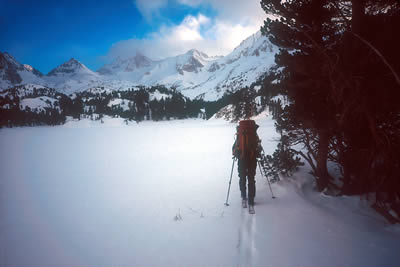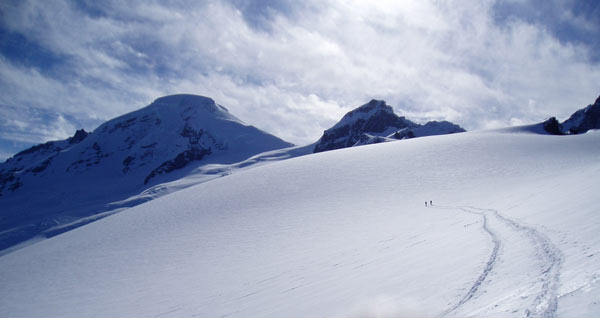Avalanche Training - AIARE 2 Overview The AIARE Rec 2 Avalanche Course is new for the 2017-2018 season. In earlier versions of the AIARE curriculum, the Level 2 course was designed to be a stepping-stone for backcountry users who were on a professional track. The new, redesigned curriculum contains a wealth of new material and has been divided into a Recreational and a Professional Track.
The AIARE Rec 2 Course builds on the AIARE 1 Decision Making Framework and the hazard management model and gives you the skills to evaluate critical hazard assessment factors. The AIARE 1 teaches you a process, and the AIARE Rec 2 builds on your experience to use a process to manage uncertainty.
The Rec 2 course is a 3-day (24-hour) course that teaches existing backcountry travelers decision making skills to deal with more complex situations that they might encounter while in avalanche terrain. It might be just that you are traveling in more complicated terrain, or maybe you are the leader of a group of other recreationalists, or maybe you need to build a tour plan but you don't have access to an avalanche forecast or other resources. You'll learn techniques to handle each of these situations, plus others, and will improve your overall decision making skills.
Avalanche Training - AIARE 2 Curriculum American Institute for Avalanche Research and Education (AIARE) was founded to provide instructors with the tools to educate students about the knowledge and decision making skills necessary to travel in avalanche terrain.
The American Alpine Institute's Avalanche Course instructors are AIARE-trained instructors and will teach the standardized AIARE curriculum on each course.
There is no nationally recognized curriculum for avalanche education in the USA. There are many avalanche courses and programs available but in large part, course providers operate according to their own personal beliefs and ideas. There are few means for the public to assess the quality of an avalanche course or instructor.
AIARE was formed to address this situation. They have developed and continue to develop standardized curriculum for a complete program of avalanche courses that meets the needs of students at all levels, from recreational to professional and from novice to advanced. AIARE has created and will continue to create course materials for instructors and students to maximize the effectiveness of both teachers and learners. They require instructors to meet pre-requisites and attend a training session before they are allowed access to AIARE materials and curriculum. In addition, instructors are required to sign an agreement stating they will abide by the guidelines established by AIARE and they are required to attend regular refreshers to maintain and improve their avalanche knowledge, instructional skills, and their understanding of the evolving AIARE curriculum and materials.
Avalanche Training - AIARE 2 Course Structure Identifying layers in the snowpack.
This course will be held over the course of a week with two evening classroom sessions mid-week (usually Tuesday and Thursday evenings) and two field days on Saturday and Sunday.
Learning Outcomes
Differentiate where specific avalanche hazards exist within the landscape and identify avalanche terrain where consequences may be more severe.
Use and interpret weather, snow, and avalanche observations to locate appropriate terrain prior to entering and while in the field.
Demonstrate leadership skills within a small team that includes facilitating small group discussion, promoting appropriate terrain selection, and utilizing simple risk management strategies.
Implement a basic forecasting framework that can be used in conjunction with and in the absences of local supporting avalanche information.
Itinerary
Evening 1: The Changing Mountain Snowpack
AIARE 1 Review
What is Uncertainty
Climate and Weather
Precipitation Types, Layers, Metamorphosis
Evening 2: Managing Terrain and Risk
Sources of Uncertainty
Snowpack Structure
Terrain Selection and Margins when planning
Terrain Selection and Margins in the field
Day 1: Making Quality Observations
Avalanche Formation and Release
Interpreting Weather Data, Snow Surface Conditions, and Snow Profiles
Craftsmanship, Relevancy, and Verification of Snow Observations
Risk Management in Small Groups
Snowpack Test in the Field
Day 2: Applying Observations to Field Decisions
Traveling in the Field as a Small Team
Field Risk Management and During Action Review
Communicating Observations to our group, other travelers, and local experts
Avalanche Training - AIARE 2 Dates & Details
We offer 2 options for our courses: Hybrid courses with two online evening interactive lectures mid-week plus 2 in-person field days
Or
Standard courses with one full day in-person classroom session plus two in-person field days (Veterans using GI Bill benefits must enroll in these standard, in-person sessions)
Each session has a maximum ratio of 6 students per instructor.
Hybrid Courses
Unless otherwise noted, these session will have the format of 2 evening online lectures from 6 - 10pm, followed by 2 in-person field days.
Hybrid Dates:
March 04 & 06 Zoom Lessons, March 8-9 Field Days
Standard
Dec 20-22
Feb 07-09
Motorized Course: : Leavenworth
If you are unable to make any of the scheduled course dates, or are interested in any variation of the AIARE Avalanche program, please contact us.
Skinning up Heliotrope Ridge on Mt. Baker's north side.
Max Ratio - 6:1 (Climber:Guide) (Minimum of 4 participants)
Capacity - 12
Prerequisites
Lodging and Logistics The field days run from 7:30am to 5:00pm each day, you must provide your own transportation, food and lodging throughout the course.
Lodging Options
It is recommend that your lodging have good internet access. You will need to be able to access the avalanche forecasts the evenings before your field days so that you can do your planning homework.
Stay each night in a Bellingham hotel and commute to AAI/ Mt. Baker Ski Area each day. The Best Western Pluse on Bennett Dr. provides discounts to all AAI program participants; just let them know you are on an AAI course.
Or camp for approximately $20 per night at Larrabee State Park , located 5 miles south of AAI right on the beach.
There are plenty of vacation rental cabins in the town of Glacier, 20 minutes from Mount Baker Ski Area. See Mount Baker Lodging for cabin options. There is usually a two-night minimum.
Please note: Lecture spaces, morning briefings, and evening analysis and discussion sessions will meet in a variety of locales, including Bellingham and Glacier, WA. It is best to make your accommodations in Bellingham for at least the first night before the course, then you are welcome to make them for somewhere between Bellingham and Glacier for the remaining evenings. Lodging at the Mountaineers Lodge or camping at the Ski Area is not recommended as the class will be meeting lower on the mountain and you will need to drive back into town before heading out to the field.
Avalanche Training - AIARE 2 Equipment Snow science practitioners and others who travel in avalanche terrain need to carry a variety of specialized gear. A full, printable equipment list can be downloaded at right. The AAI Equipment Shop
Snow Study Tools
A field book, crystal card, thermometer, and loupe are all you need to gather data in the course of day tours in the backcountry.
Many snow study kits are designed as marketing devices to sell as much gear as possible. Our selection is based on the gear our guides actually carry in the field. As guides who use snow science in the course of actual backcountry travel (as opposed to full-time avalanche control operations), we recommend a stripped-down kit that will actually make it into your pack when you leave the parking lot.
American Avalanche Association SWAG
Required for the Level II course, this document was produced through the cooperative efforts of the American Avalanche Association and the Forest Service National Avalanche Center. Among other things, it aims to set standards for observing and collecting avalanche data in the U.S.
Click here to buy the SWAG .
Avalanche Safety Gear Rentals The AAI Equipment Shop rents avalanche gear, including beacons, probes, and shovels.
We also have packs and ski poles for rent, see AAI rental pricing sheet.
WE NOW HAVE BACKCOUNTRY SKIS!
WE ALSO HAVE SPLITBOARDS!
See AAI rental pricing sheet
Please note that rental equipment availability is limited, so be sure to contact the Shop early to reserve your gear!
There are also skis and snowboards available for rent at the Glacier Ski Shop at 360-599-1943.
Avalanche Training - AIARE 2 Related Courses
Program Finder
By Location
United States - Alaska
United States - Washington
United States - California
United States - Nevada
United States - Colorado
United States - Utah
Canada - British Columbia
South America - Argentina
South America - Bolivia
South America - Ecuador
South America - Patagonia
South America - Peru
Europe - Alps and Caucasus
Asia - Nepal and Tibet
Asia - Laos, Thailand, & Vietnam
Asia - China
Asia - Japan
Africa - Tanzania
Pacific and Antarctica
By Program Type
Instructional Courses
Group Summit Climbs
Expeditions
Skills Expeditions
Private Guided Programs
Treks, Tours, & Backpacking
Corporate Outings & Services
Government & Military
By Activity
Rock Climbing
Ice Climbing
Alpine Climbing
High-Altitude Climbing
Trekking and Backpacking
Skiing & Snowboarding
Guide Training & Rescue
Avalanche Training
Departure Month
Difficulty Level
Beginner
Moderate
Intermediate
Advanced
Very Advanced
x
